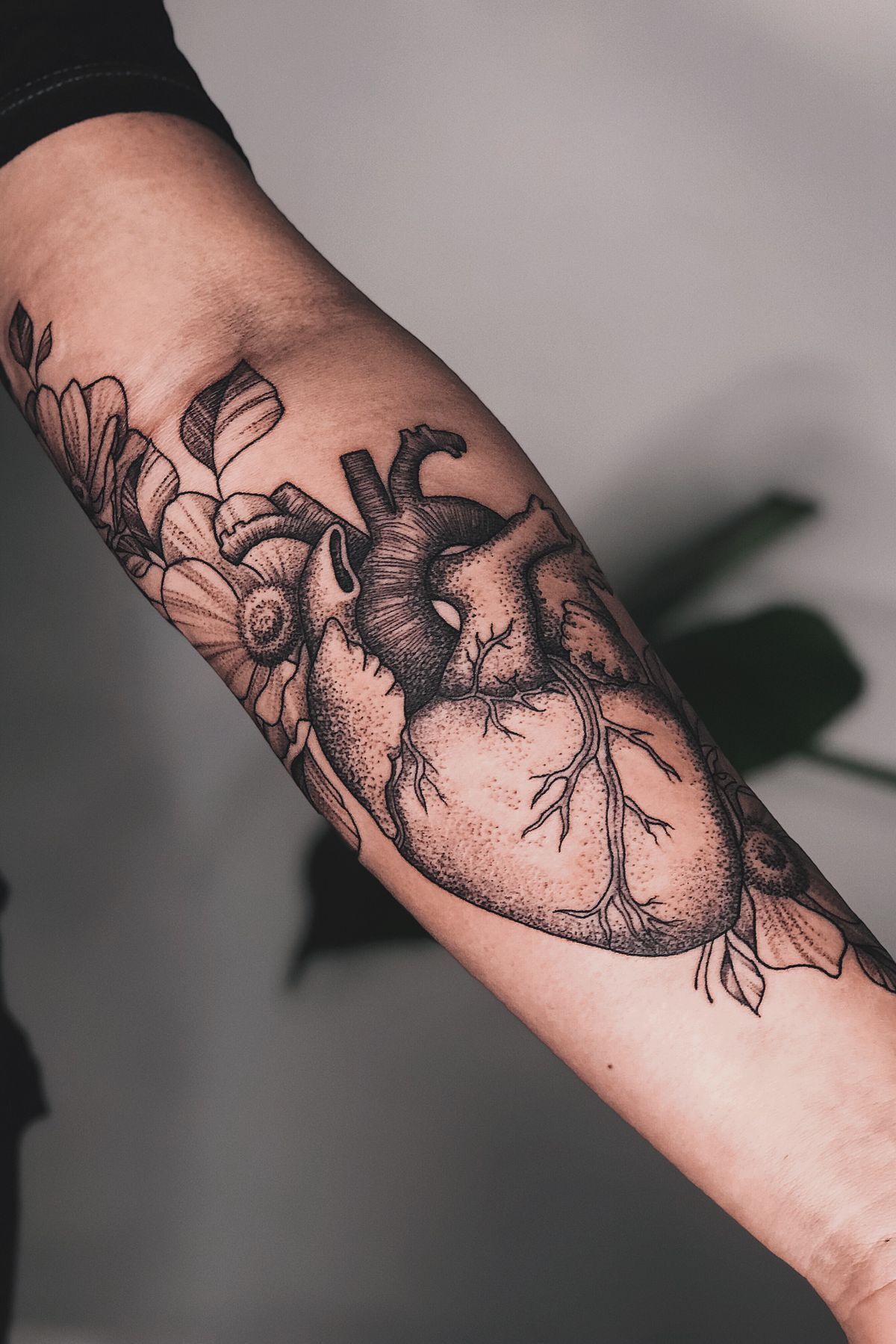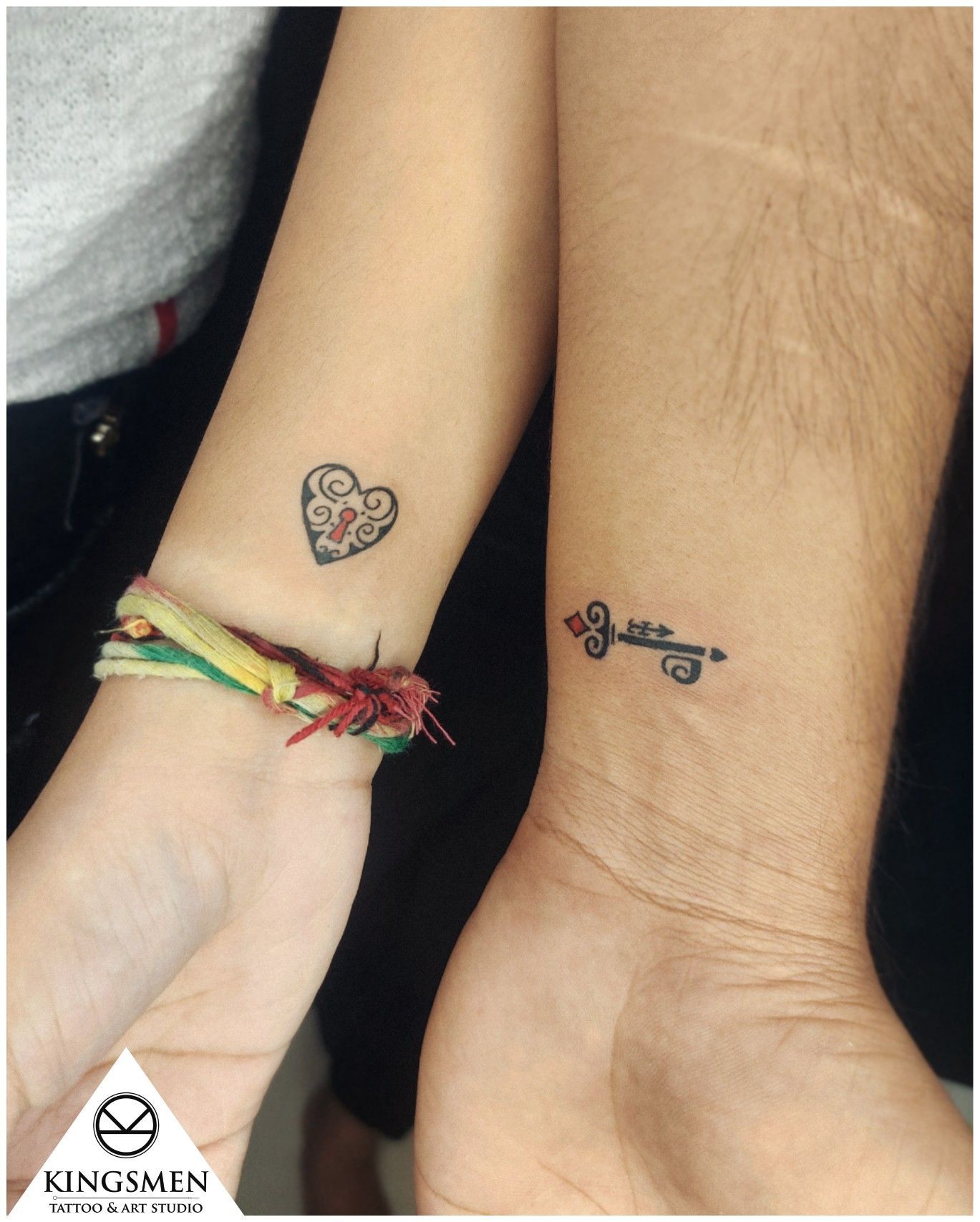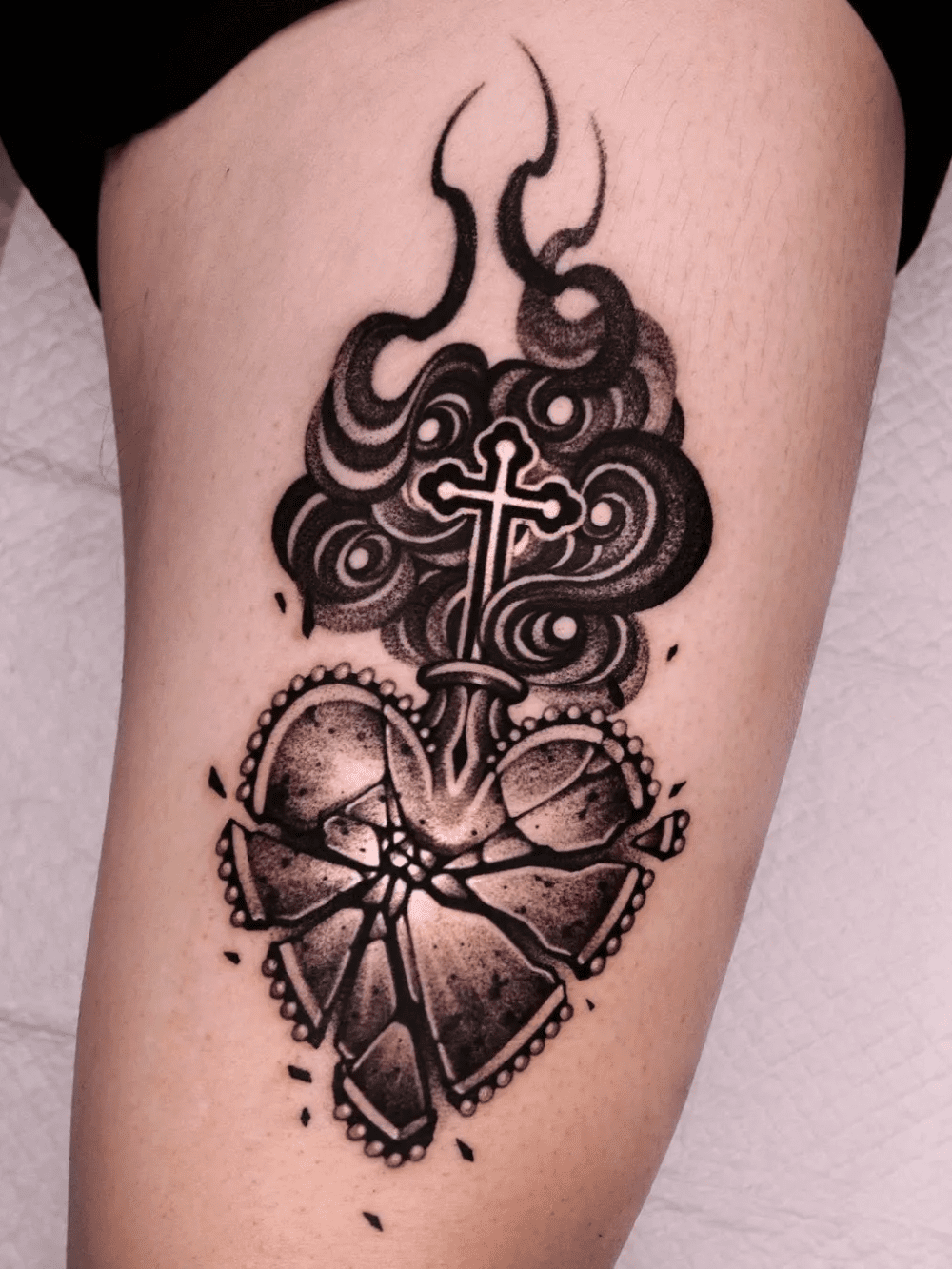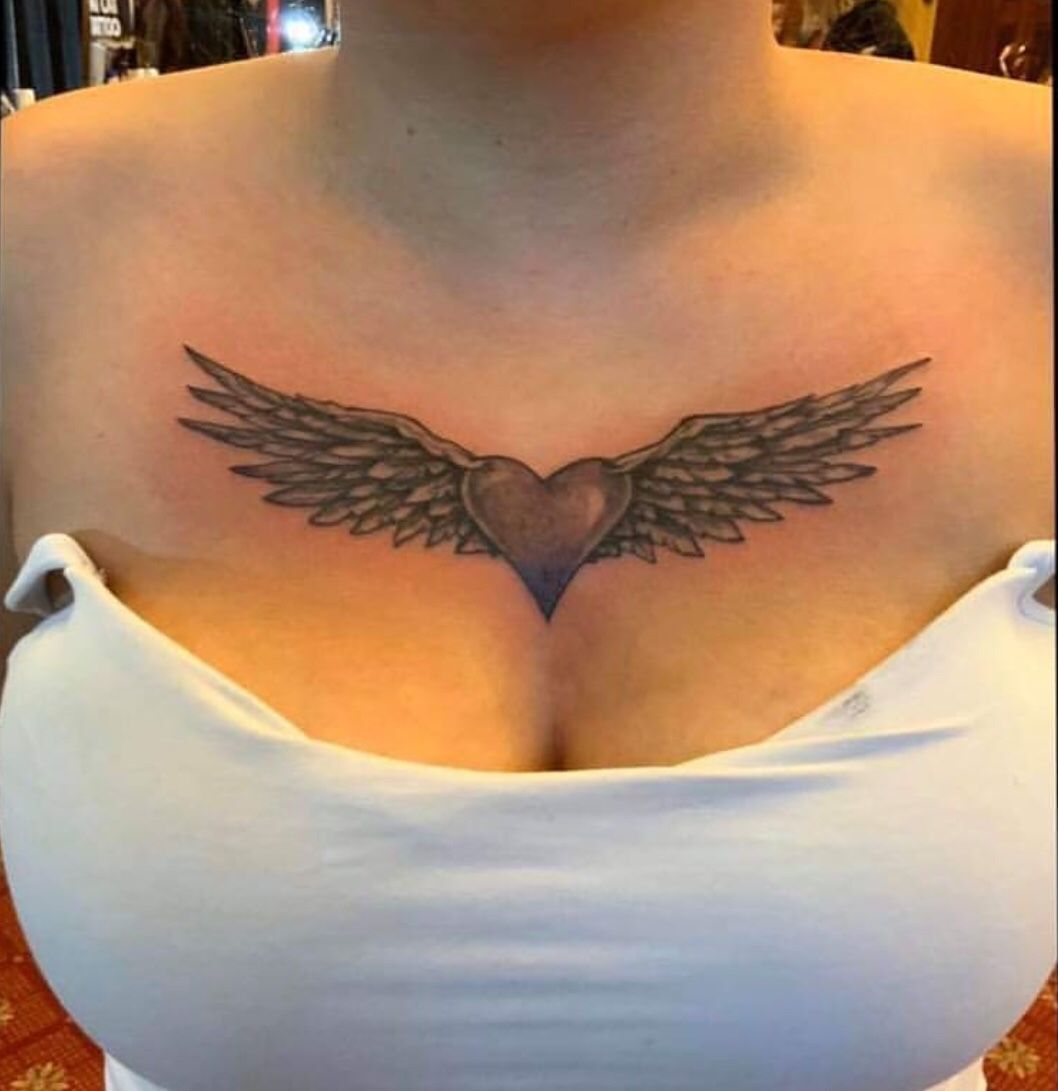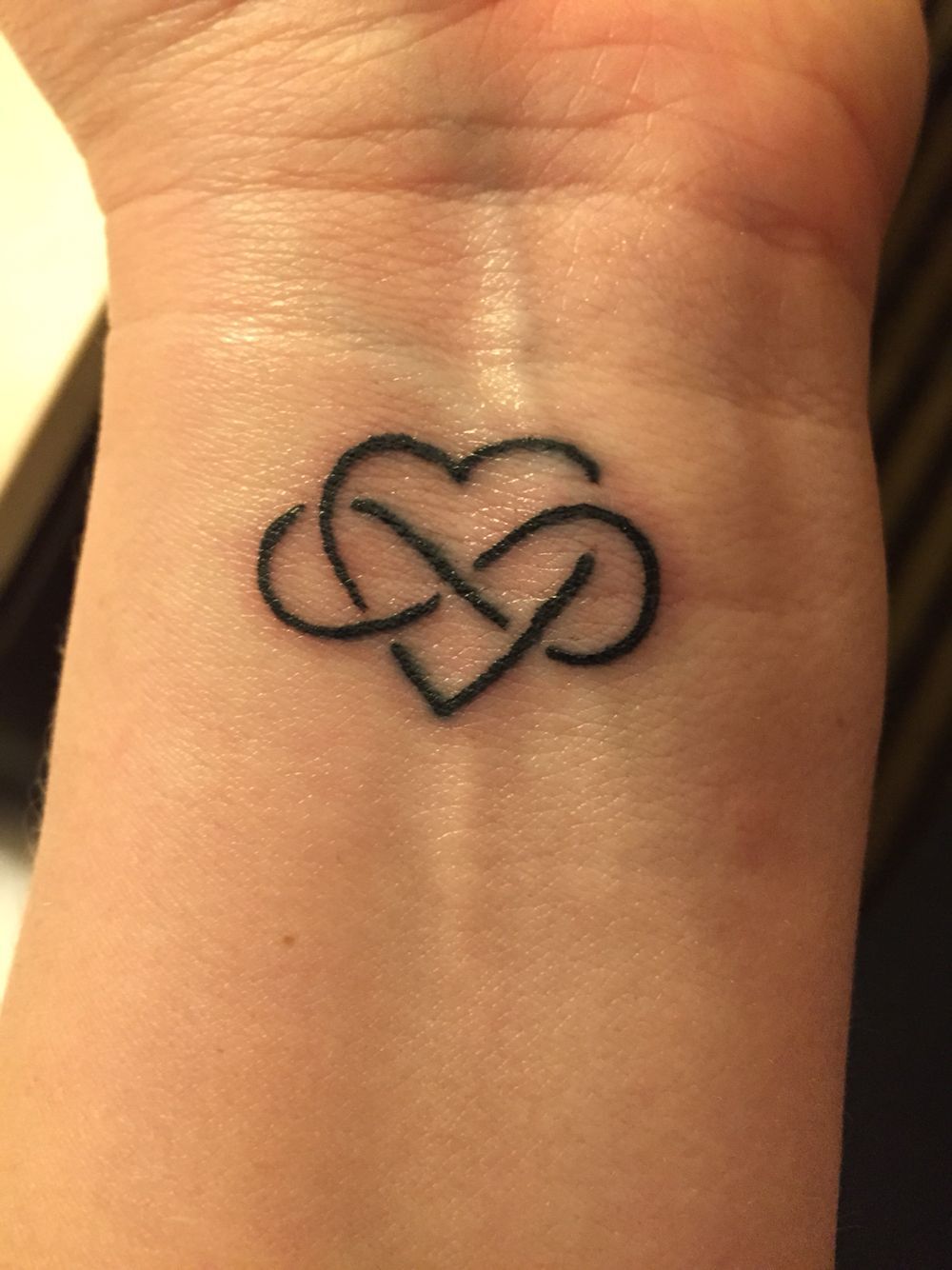Heart tattoos are a popular and timeless design that has been around for centuries. The heart symbol has been used in art and literature throughout history, representing love, emotion, and passion. In this article, we will explore the symbolism and meaning behind heart tattoos and some popular designs and ideas. We will also discuss who should get a heart tattoo and the history and origin of the design.
Are you only interested in tattoo designs and want to skip the educational part?
No problem, we got you covered! Click HERE to get inspired.
What does the heart symbolize?
The heart symbolizes a wide array of concepts across different cultures and traditions, but there are a few universal associations that are almost always related to it. Here are some of the most common symbolisms:
Love: This is perhaps the most universal and popular symbolism of the heart. It often represents romantic love, but it can also denote familial love, friendship, and compassion.
Life and Vitality: Since the heart is a vital organ in the body, it often symbolizes life itself, vitality, and health.
Emotions: The heart is also associated with emotions, especially strong ones. This is because people often feel a physical reaction in the area of the heart when they experience intense feelings.
Soul or Spirit: In many religious and spiritual traditions, the heart is seen as the seat of the soul or spirit. It's the part of the body where the essential self is thought to reside.
Courage and Bravery: This symbolism comes from ancient cultures like the Egyptians and Greeks, who believed that the heart was the source of human bravery and courage.
Wisdom and Intellect: In some traditions, the heart is also associated with wisdom or intellect. This can be traced back to Ancient Egypt where the heart, not the brain, was considered the seat of intelligence.
It's worth noting that the symbolism can change depending on the context, the color of the heart, and even the direction it's facing. For example, a broken heart symbolizes lost love or grief, a red heart is associated with passion and desire, while a yellow or gold heart can symbolize friendship and happiness.
What is the meaning behind heart tattoos?
The meaning behind a heart tattoo can vary greatly depending on the design, the person wearing it, and the cultural context. However, here are some common interpretations:
Love: Heart tattoos are most commonly associated with love. This could be romantic love, but it could also signify love for a family member, a friend, or even a concept or idea.
Loss or Grief: A broken heart or a heart with an arrow through it can symbolize loss or grief, particularly the end of a relationship or the death of a loved one.
Strength and Courage: The heart is also a symbol of strength and courage, and a heart tattoo can represent the wearer's resilience in the face of adversity.
Freedom and Rebellion: Heart tattoos, particularly those with wings or those in the "sailor jerry" style, can symbolize freedom, rebellion, or a love for travel and adventure.
Spirituality and Faith: In many religions, the heart represents the soul or spirit, and a heart tattoo can be a symbol of spirituality or faith. This is particularly common with sacred heart tattoos, which are associated with Catholicism.
Memory: Some people get heart tattoos as a memorial to a loved one who has passed away. These tattoos often incorporate the person's name or initials, and sometimes their dates of birth and death.
Life Affirmation: Given that the heart is an essential organ for life, some see it as a symbol of life itself. Having a heart tattoo could mean an affirmation of life, a celebration of living, or an appreciation for life's moments.
Femininity: Traditionally, hearts have been associated with femininity, and a heart tattoo could represent femininity or female power.
best heart tattoo ideas and their meanings
Tattoos are a unique form of self-expression, enabling us to wear our hearts on our sleeves, quite literally in some cases. The heart, as a symbol, carries a rich palette of meanings, ranging from love and compassion to strength and resilience. The heart's versatility makes it an ideal choice for a tattoo, resonating with the profound personal meanings each person attaches to it.
Here are five heart tattoo design ideas, each carrying its own significant symbolism and story, that might inspire your next or first ink:
Anatomical Heart Tattoo
This design shows the heart as it actually appears in the body, complete with veins and arteries. It's a more realistic portrayal compared to the iconic heart shape, and it can symbolize a love for science or medicine, or it might represent a more raw, real, or complex view of love.
Heart Lock and Key Tattoo
This design consists of a heart-shaped lock with a key or a keyhole. It may symbolize that someone has the key to your heart, or it could represent a mystery or secret that you hold deep within your heart.
Sacred Heart Tattoo
The Sacred Heart is a traditional Catholic symbol that shows a heart surrounded by thorns, often aflame, and sometimes with a cross on top. This tattoo could represent a deep devotion to one's faith, divine love, or spiritual transformation.
Heart with Wings Tattoo
A heart with wings can symbolize freedom, a free spirit, or the idea of love taking flight. It could also represent a love for travel, or it might symbolize a love that has passed on or is distant.
Infinity Heart Tattoo
This design combines the heart with the infinity symbol, representing eternal love. This tattoo could symbolize everlasting love for a partner, a family member, or even a concept like peace or hope. It can also be a symbol o
Who should get a heart tattoo?
A heart tattoo can be a great choice for anyone who resonates with the symbolism it carries. Here are some considerations that might help you determine if a heart tattoo is right for you:
Personal Significance: If the symbol of the heart holds a special significance for you, whether it's related to love, resilience, spirituality, or other aspects mentioned earlier, a heart tattoo could be a meaningful choice.
Expressing Emotion: If you're someone who appreciates the symbolism of the heart in relation to emotions and you'd like to express your feelings openly, a heart tattoo could serve as a physical manifestation of your emotional side.
Memorial or Dedication: Heart tattoos can serve as memorials or dedications to loved ones. If you're considering a tattoo as a tribute to someone special, a heart design might be fitting.
Aesthetics: Some people simply like the visual appeal of heart tattoos. If you're attracted to the shape and design possibilities of heart tattoos, this could be a good choice for you.
Religious or Spiritual Beliefs: If you have strong religious or spiritual beliefs, particularly if you're connected with traditions that venerate the heart (like the Sacred Heart in Catholicism), a heart tattoo can be a representation of your faith.
Remember, getting a tattoo is a personal decision and a form of self-expression. It's always crucial to choose a design that resonates with you personally. Additionally, considering the permanency of tattoos, it's advisable to think carefully about the decision and ensure you're getting a tattoo for reasons that are important to you.
General Breakdown Of Tattoo Pain Levels On Different Body Parts
Here is a breakdown of the different tattoo pain levels:
- Low: This level of pain is generally described as a mild discomfort or tickling sensation. It is similar to the sensation of getting a light scratch or scrape.
- Moderate: This level of pain is generally described as a moderate discomfort or aching sensation. It is similar to the sensation of getting a deep scratch or scrape or being pinched.
- High: This level of pain is generally described as a strong discomfort or throbbing sensation. It is similar to the sensation of getting a burn or being stung by a bee.
It's important to note that pain tolerance is highly individual and can vary greatly from person to person. Some people may find certain body parts more or less painful than others, and the same body part can be more or less painful for different people. Additionally, the level of pain can be affected by factors such as the size and location of the tattoo, the skill of the tattoo artist, and the individual's own pain threshold.
Tattoo placement pain level chart
Body Part | Pain Level | Explanation |
Forehead | Low | The forehead has few nerve endings, so it is not a particularly painful area. |
Eyebrows | Low | The eyebrows have few nerve endings, so the pain level is relatively low. |
Ear | Low | The ear is a relatively thin and fleshy area, so the pain level is low. |
Nostril | Low | The nostril is a small area with thin skin, so the pain level is low. |
Lip | Low to Moderate | The lip has more nerve endings than some other areas, so it may be slightly more painful. |
Cheek | Low to Moderate | The cheek has a moderate amount of nerve endings, so it may be slightly more painful. |
Moderate | The neck has a moderate amount of nerve endings, so it may be slightly more painful. | |
Moderate to High | The chest has a high concentration of nerve endings, so it can be quite painful. | |
Abdomen | High | The abdomen has a high concentration of nerve endings, so it can be quite painful. |
Back | High | The back has a high concentration of nerve endings, so it can be quite painful. |
Shoulders | High | The shoulders have a high concentration of nerve endings, so they can be quite painful. |
Upper Arms | Moderate to High | The upper arms have a moderate to high concentration of nerve endings, so they can be somewhat painful. |
Elbows | High | The elbows have a high concentration of nerve endings, so they can be quite painful. |
Forearms | Moderate | The forearms have a moderate concentration of nerve endings, so they are not as painful as some other areas. |
Hands | High | The hands have a high concentration of nerve endings, so they can be quite painful. |
Lower Arms | Low to Moderate | The lower arms have a lower concentration of nerve endings, so they are not as painful as some other areas. |
Wrists | Low | The wrists have a low concentration of nerve endings, so they are not very painful. |
Lower Back | High | The lower back has a high concentration of nerve endings, so it can be quite painful. |
Buttocks | High | The buttocks have a high concentration of nerve endings, so they can be quite painful. |
Thighs | High | The thighs have a high concentration of nerve endings, so they can be quite painful. |
Knees | High | The knees have a high concentration of nerve endings, so they can be quite painful. |
Calves | Low to Moderate | The calves have a low to moderate concentration of nerve endings, so they are not as painful as some other areas. |
Ankles | Low | The ankles have a low concentration of nerve endings, so they are not very painful. |
Tattoo aftercare tips
Before getting a tattoo:
Choose a reputable tattoo artist and parlor. Research the artist's portfolio and read reviews from previous clients.
Consult with the artist about the design and placement of the tattoo.
Make sure you are in good health. If you have any medical conditions or are taking any medications that may affect your ability to heal, be sure to let your tattoo artist know.
Consider using a numbing cream to reduce pain during the tattooing process. These creams contain a numbing agent (such as lidocaine) that can be applied to the skin before the tattoo is done. It's important to follow the instructions on the numbing cream and to only use it as directed.
Avoid alcohol, caffeine, and other substances that can thin your blood for at least 24 hours before getting a tattoo.
Eat a healthy meal before your tattoo session to ensure that your blood sugar is stable.
Wear loose, comfortable clothing that allows easy access to the area being tattooed.
After getting a tattoo:
Follow the aftercare instructions provided by your tattoo artist. These may include:
Keeping the tattoo clean and covered with a bandage for the first few hours after getting tattooed.
Washing the tattoo with lukewarm water and a mild soap (such as unscented, antimicrobial soap) and patting it dry with a clean towel.
Applying a thin layer of tattoo ointment or lotion (such as A&D or Aquaphor) to the tattoo and covering it with a clean bandage or wrap.
Repeating this process for the first few days, or until the tattoo has fully scabbed over.
Avoid soaking the tattoo in water for the first week, such as in a bath or pool.
Avoid picking or scratching at the scabs, as this can cause the tattoo to fade or become infected.
Avoid exposure to direct sunlight or tanning beds for at least 2-4 weeks.
If you experience any redness, swelling, or unusual discharge, contact your tattoo artist or a healthcare professional.
Overall, it's important to keep your tattoo clean and moisturized during the healing process to ensure that it heals properly and looks its best. Using a numbing cream can help reduce pain during the tattooing process, but it's important to use it as directed and to follow all aftercare instructions to ensure that your tattoo heals properly.
People Also Ask:
What is the symbolism of a heart tattoo positioned on the wrist?
A heart tattoo inked on the wrist often represents love, loyalty, and a deep connection with oneself. It can also symbolize an openness to share and express love and feelings, given its visible location.
What's the significance of a heart tattoo on the finger?
A heart tattoo etched on the finger usually stands for love, fidelity, and dedication. It can also denote the wearer's belief in the power of love and its essential role in their life.
What does a heart tattoo located on the ankle represent?
A heart tattoo inked on the ankle may symbolize passion, love, and a bond with nature. Given its lower position on the body, it might also suggest a grounding influence of love in the person's life.
What's the meaning of a heart tattoo on the thigh?
A heart tattoo positioned on the thigh often signifies passion, love, and a strong connection to one's inner self. It could also suggest a sense of private or intimate love given its typically concealed location.
What's the symbolism of a heart tattoo on the chest?
A heart tattoo emblazoned on the chest typically represents love, deep emotions, and passion. It can also symbolize one's heart and soul, metaphorically connecting to the physical location of the actual heart.
What does a heart tattoo behind the ear signify?
A heart tattoo located behind the ear might represent an affinity for listening to one's heart or love whispered quietly. Given its discrete location, it could signify private or personal love.
What's the significance of a heart tattoo with a rose?
A heart tattoo combined with a rose often symbolizes romantic love, passion, and beauty. It can also represent the balance between the joy and pain that love can bring, given the rose's association with both beauty and its thorns.
What does a heart tattoo under the eye mean?
Traditionally, a tattoo under the eye, also known as a "teardrop tattoo," can have various meanings, some of which are associated with prison culture. A heart tattoo under the eye can signify love lost or a deep love that has led to personal sorrow.
What's the meaning of a heart tattoo with an arrow?
A heart tattoo design featuring an arrow often represents passionate love or a significant impact love has had on the individual. This symbol has its roots in Greek mythology, where Eros (Cupid) would use his bow and arrow to make people fall in love.
What's the symbolism of a heart tattoo with a name?
A heart tattoo incorporating a name typically symbolizes deep affection or love for the person whose name is included. This could be a partner, family member, or even a pet. It's a personal and clear declaration of love and attachment.
Watch A video of a Heart tattoo done by a pro
200+ Heart tattoo Ideas For Your Inspiration
Final thoughts:
In conclusion, heart tattoos are a popular and timeless design with various meanings and interpretations. Whether it's to express love and devotion to a significant other, to honor a loved one who has passed away, or to represent self-love and acceptance, heart tattoos can be a powerful and meaningful symbol. With so many different designs and placement options, there's a heart tattoo for everyone. Remember, a tattoo is a permanent decision, and you must be sure that you want the tattoo before getting it.

